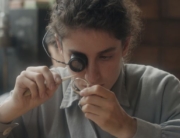Over a long night and into the next day, a homicide case in the barren environment of a rural Turkish town gradually exposes how men struggle to conduct themselves within their expected public and private roles, even as the absolutes towards the women in their lives keep shifting. Oh, and the crime may get solved as well.
In the prologue, the sun sets behind the garage of Yasar the mechanic as his co-workers commiserate drunkenly over his murder and a dog barks incessantly in the encroaching darkness. (A love triangle is first hinted at here.) The local officials intend to carry out the formal investigation—interrogating the suspects, confirming their motives and methods, and examining the victim. The bare bones are very CSI, but director Nuri Bilge Ceylan leisurely unfolds the story over four acts across the Anatolian hills.
First, they have to find the body. Stuffed in the police car, the aggressive, and annoyed, police chief Naci (Yilmaz Erdogan) browbeats the driver, nicknamed Arab Ali (Ahmet Mumtaz Taylan). He just wants to beat out of the miserable chief suspect, Kenan (Firat Tanis), the location of the body—the abuse is more emotional than physical. Meanwhile, the suspect gives confusing directions as to which fountain he buried the victim nearby after a drunken bar fight with Yasar that resulted when secrets were blurted out.
Two educated men of the town accompany the police to assure correct procedures are followed: the prosecutor Nusret (Taner Birsel) and Doctor Cemal (Muhammet Uzuner), who talk about their lives to pass the lengthening hours in the cramped, forced companionship. (Co-scripter Ercan Kesal, writing along with the director and his wife Ebru Ceylan, was a doctor on a similar investigation, and the dialogue has that sense of verisimilitude.) As the sky grows darker and the roads become more winding and narrow, they stop at first one site, then another, and another, where, in almost Keystone cop fashion, the two trailing cars empty each time of their assistants, cops, diggers, and, a second, chubby, blubbering suspect, who turns out to be Kenan’s brother. Sometimes the passengers change places, and the conversations take different turns of revelation and introspection that add depth to the characterizations—and become clues to the eventual decisions made about the case.
In act two, the night is too dark to continue the search, and so the men stop to stay over in a traditional village, under the hospitality of the local leader (Ercan Kesal), who is only too happy to curry favor with town officials who could help him with bureaucratic favors. Suddenly, and climactically for the film, the mayor’s lovely daughter comes in to serve the meal, lit angelically by candles. Within what had been an all-male environment, the men are emotionally stirred to remember the women in their lives (whether alive or dead, mother, lover, wife, or ex-wife), and their responsibilities (or failures) to them. Confessions tumble out.
In act three, the suspect finds the right fountain in the light of day, and the gruesome grave is uncovered. The doctor and prosecutor swing into professional mode; the suspects are distraught. In act four, they all return to town to face the consequences—the stunned widow, the anger of her son, and the cold reality of the hospital autopsy table. But everything the participants in the search experienced and revealed about themselves comes to bear in how the doctor chooses, unpredictably, to dispose of the case so all can move on. Against the sweep and details of the Anatolian landscape, as dreamily shot by cinematographer Gokhan Tiryaki, who also worked on Ceylan’s even more enigmatic Three Monkeys (2008) and Climates (2006), matters of life and death are subject to interpretation—and for the thoughtful audience as well.






Leave A Comment